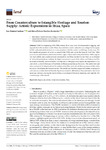From Counterculture to Intangible Heritage and Tourism Supply: Artistic Expressions in Ibiza, Spain

Ver/Abrir
Use este enlace para citar
http://hdl.handle.net/2183/29428Colecciones
- Investigación (FEE) [923]
Metadatos
Mostrar el registro completo del ítemTítulo
From Counterculture to Intangible Heritage and Tourism Supply: Artistic Expressions in Ibiza, SpainFecha
2022Cita bibliográfica
Ramón-Cardona, J.; Sánchez-Fernández, M.D. From Counterculture to Intangible Heritage and Tourism Supply: Artistic Expressions in Ibiza, Spain. Land 2022, 11, 98. https://doi.org/10.3390/land11010098
Resumen
[Abstract] Until the beginning of the 20th century, Ibiza was rural, developmentally lagging, and separate from the modern world. These characteristics made it attractive as a refuge for European intellectuals and artists as soon as communications with the outside world began to develop. The first significant presence of artists occurred in the 1930s, just before the Spanish Civil War. After years of war and isolation, artists returned in a larger volume and variety than before. Other regions also had artistic and countercultural communities, but Ibiza decided to use them as an element of its tourist promotions, making the hippie movement a part of its culture and history and the most internationally known element. The objective of this paper is to expose the importance of art and artists, a direct inheritance of that time, in Ibizan promotion and tourism. The authorities and entrepreneurs of the island realized the media interest they received and the importance of this media impact on developing the tourism sector. The result was that they supported artistic avant-garde and various activities derived from the hippie movement to differentiate Ibiza and make it known in Spain and abroad, creating the myth of Ibiza as an island of freedom, harmony, and nightlife (the current image of the island).
Palabras clave
Hippie
Art
Artists
Promotion
Tourism
Ibiza
Art
Artists
Promotion
Tourism
Ibiza
Versión del editor
Derechos
Atribución 4.0 Internacional
ISSN
2073-445X






